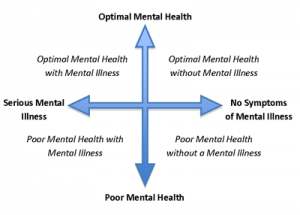Why now?
In August 2017, the Prevention Concordat for better mental health was published, setting out a consensus statement from a range of organisations intending to improve the prevention of mental illness and the promotion of mental health. Work is now underway to consider what this means for people with learning disabilities or autism.
A note on language
Language is contested in mental health services, as some people reject the ‘medical model’ and prefer to speak of distress rather than illness, while others assert that distress is part of life and should not be seen as a health problem at all. It may be, rather, a challenge for personal growth, social justice or community diversity.

This diagram offers two axes. It shows that some people enjoy mental health in the midst of illness, while others languish in poor mental health without any signs of mental illness at all.
Similarly, a strategy to ‘prevent’ mental illness would not be the same as a strategy to promote mental wellbeing, as stopping bad things happening is not the same as starting good things happening. This page will use the term person or people where others might say patient, service user, client, survivor or expert by experience. Others will be labelled as staff, family or friends.
Who is at risk?
Several formats may be used to categorise the work, including those familiar to mental health services, such as ‘child and adolescent’, forensic, IAPT and so on. Alternatively, the Equalities Act 2010 offers a list of protected characteristics that include groups who are at increased risk of mental health difficulties. Mental Health awareness initiatives have targeted sectors of modern culture, such as the media. The Life Domains approach suggests valued roles and relationships in the community that can become the focus of transformation.
The JSNA Toolkit summarises evidence on prevalence and then uses the following categories: people, place, perinatal, children and young people, working age adults, living well in older years. There is also a framework linking social determinants with mental health issues.
The focus of this page will be people with learning disabilities or who are on the autistic spectrum.
A framework to organise our thinking
The Government offers the following six categories for mapping the work:
- leaders – politicians, senior managers
- public health staff
- strengthening communities
- improving wellbeing for all
- intervening early in distress
- improving health and wellbeing for people with mental illness
The Marmot Review identified six objectives for health promotion:
- Give every child the best start in life
- Enable all children, young people and adults to maximise their capabilities and have control over their lives
- Create fair employment and good work for all
- Ensure a healthy standard of living for all
- Create and develop healthy and sustainable places and communities
- Strengthen the role and impact of ill-health prevention
What do we know already?
Mental Elf commented on prevention work across the mental health field in May 2018. Youth mental illness across the whole population is discussed here. A 2018 paper in the Lancet is here (behind a £wall). Guidance has been provided for commissioners , along with a tool for calculating return on investment and advice on leadership and workforce development in this field. Specific information about mental health issues for people with learning disabilities or autism is found in Reasonably Adjusted?
Selecting beacon projects
We might argue that every organisation, group and network that offers anything positive to anyone is a candidate for recognition. Supporting people to have a good life whilst living with mental health issues counts, as does supporting people who are in a specific at risk group. Way upstream, projects that make paid work fun, that link parents, that promote exercise and contribution are all promoting good mental health and helping to prevent deterioration. So we must focus.
A project worth listing here is one that is intentional about the potential to prevent mental ill health. It will work with groups who are at particularly high risk. It will be explicit about the mental health agenda, naming the issue and promoting lifestyle choices that deliberately build resilience. It will attempt to measure mental health outcomes and shape its work to increase its impact in this field. That is not to say that projects that take a more subtle approach are invalid; just that providing a focus in this way will shine the brightest light on positive approaches.
Some examples
- In a tiny local example of achiving social change, Philipa R asked her local branch of Marks & Spencer to place a sofa near the checkout so that people who needed to could sit down for a while. The branch has reported increased footfall in the store. Such minor, reasonable adjustments make everyday life less stressful for people who need it.
- Slimming World have made some adjustments to their programme to include people with learning disabilities. See here.
- Cinemas are promoting autism-friendly screenings – see here.
- Sibs runs support groups for the adult siblings of people with autism or learning disabilities. See here.

Recent Comments